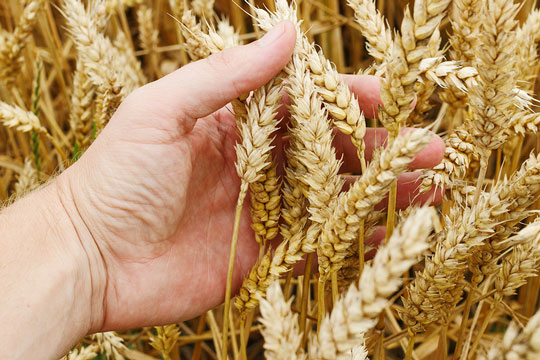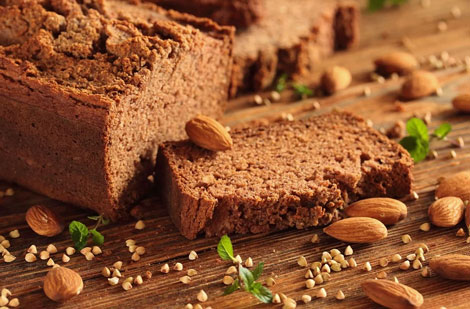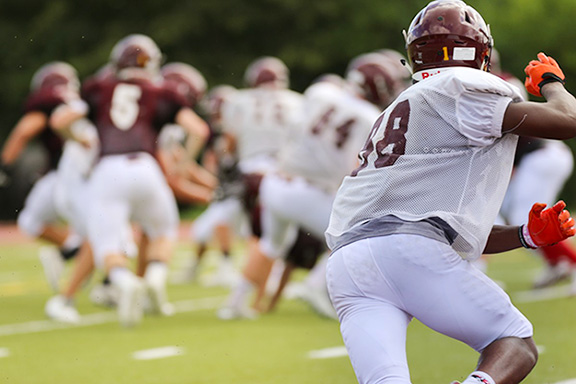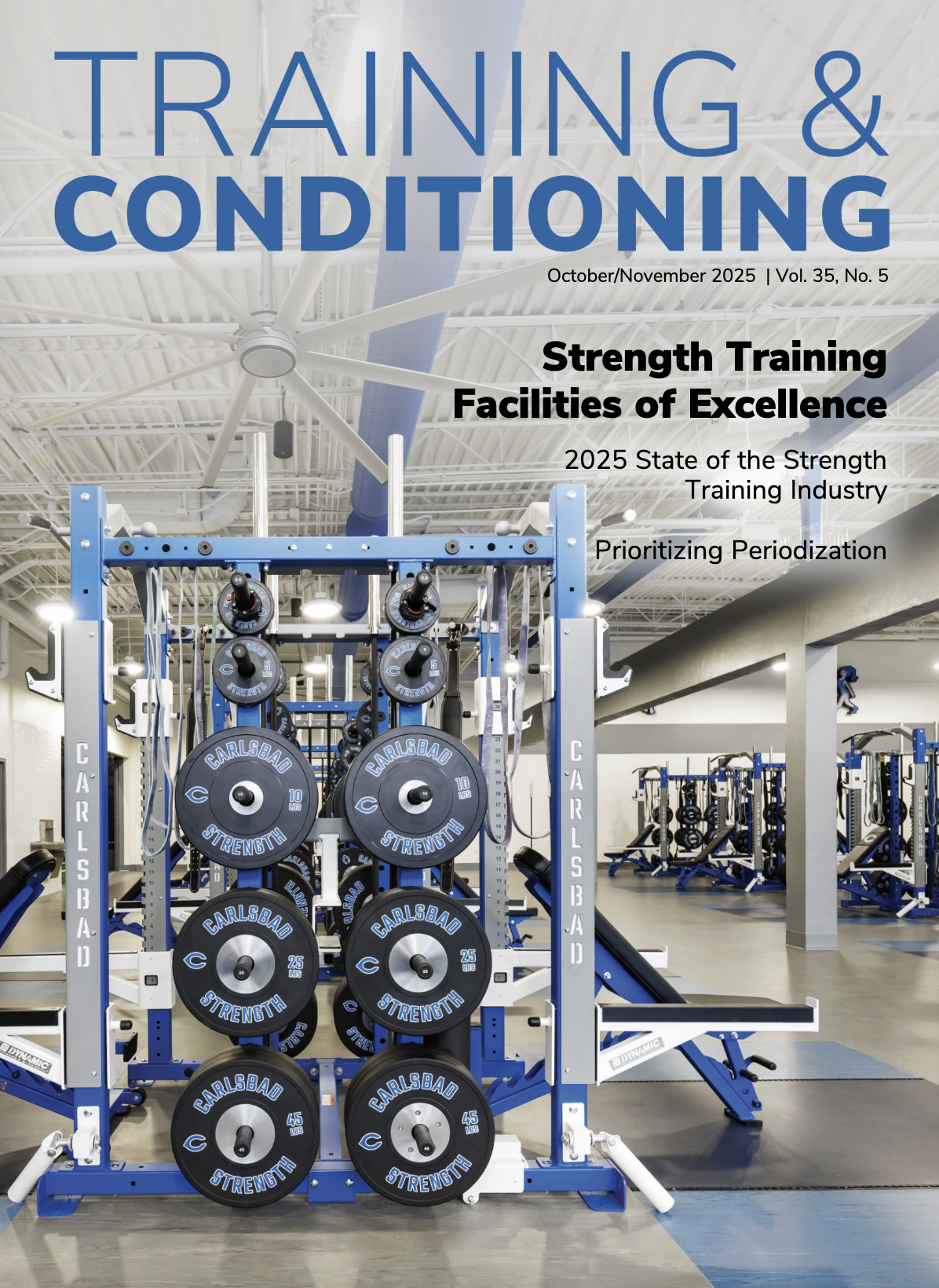Jan 29, 2018When athletes go gluten-free
A growing list of athletes say a gluten-free diet enhances their performance. What are the myths and truths of this trend?
 Whether it’s for medical reasons or a personal choice, the number of people dropping gluten from their diets is increasing — and athletes are part of the trend. Some of the increase can be attributed to better recognition and diagnosis of celiac disease, but there are more than a few elite athletes who do not have a medical condition and have decided to go gluten-free.
Whether it’s for medical reasons or a personal choice, the number of people dropping gluten from their diets is increasing — and athletes are part of the trend. Some of the increase can be attributed to better recognition and diagnosis of celiac disease, but there are more than a few elite athletes who do not have a medical condition and have decided to go gluten-free.
These athletes often cite alleviation of gastrointestinal symptoms, improved mental acuity and focus, having more energy, and improved performance as advantages of forgoing gluten-containing products. While there is no research to support or refute a performance-enhancing effect, the many anecdotal reports of improved overall wellbeing and athletic gains cannot be discounted.
Defining reactions
The term “gluten intolerance” is often used when referring to the entire category of gluten- and wheat-related issues: celiac disease, wheat allergy, non-celiac gluten sensitivity, and other less understood reactions to gluten or wheat. But it is important to have a thorough understanding of each of these conditions when discussing nutrition’s role in combating them.
→ Celiac disease (CD) is an inherited autoimmune disorder that is thought to affect about one percent of the population. The ingestion of gluten — a protein found in wheat, rye, barley, spelt, and oats (except those certified gluten-free) — triggers an antibody that attacks the lining of the small intestine. The result is villous atrophy, the hallmark sign that distinguishes CD from other types of gluten intolerance. Since damaged villi cannot effectively absorb nutrients, a wide array of nutritional deficiencies can ensue. A completely gluten-free diet is the only known treatment for CD.
Common symptoms include abdominal bloating, cramps, and gas; diarrhea, constipation, or both; steatorrhea (fatty stools); anemia due to folic acid, vitamin B12, or iron deficiency; and unexplained weight loss. Dermatitis herpetiformis — a blistering, itchy skin rash typically seen on the face, elbows, knees, and buttocks — is sometimes seen with CD. Other symptoms may include bone or joint pain, fatigue, depression, and migraine headaches.
If CD goes untreated, long-term problems can include anemia, early-onset osteopenia or osteoporosis, vitamin and mineral deficiencies, nervous system disorders, fertility problems, and intestinal lymphomas. According to the Celiac Disease Foundation, some autoimmune disorders and other conditions are now believed to be associated with CD in some way. Some examples are type 1 diabetes mellitus, Hashimoto’s thyroiditis, fibromyalgia, chronic fatigue syndrome, rheumatoid arthritis, Addison’s disease, and autoimmune hepatitis.
» ALSO SEE: Vegan diets can come with nutrient deficiencies
Celiac disease is diagnosed serologically. A doctor orders one or more blood tests to measure the body’s response to gluten. According to the Celiac Disease Foundation, the most sensitive and commonly used test is anti-tissue transglutaminase antibody detection. If the blood tests and symptoms indicate CD, a physician may suggest a biopsy of the small intestine’s lining to confirm the diagnosis. For accurate results, an athlete needs to have been consuming gluten for at least four weeks prior to any testing for CD.
→ A wheat allergy causes the immune system to negatively respond to wheat and can affect tissues throughout the body. This immune response is often short-lived and does not cause lasting harm. Symptoms occur within a few minutes to a few hours after eating wheat and may include swelling and itching of the mouth or throat; hives, an itchy rash, or swelling of the skin; nasal congestion; itchy, watery eyes; abdominal cramps, diarrhea, nausea, or vomiting; and anaphylaxis. A wheat allergy can be diagnosed with skin or blood tests. When a wheat allergy is present, one must avoid wheat, but can eat other sources of gluten.
→ A non-celiac gluten sensitivity is a non-allergic, non-autoimmune condition in which the symptoms may be similar to those of CD or a wheat allergy. However, in contrast to CD, a non-celiac gluten sensitivity is characterized by negative antibodies and a lack of intestinal damage. It’s estimated that up to 6% of the population has a non-celiac gluten sensitivity.
While it has been debated, experts currently believe there are no biomarkers that can consistently and accurately diagnose non-celiac gluten sensitivity. Thus, if CD and wheat allergy have been ruled out, trying a gluten-free diet can provide clues. If symptoms improve, a non-celiac gluten sensitivity can be assumed.
→ Other reactions may be related to gluten and/or wheat as well. An emerging school of thought is that certain short-chain carbohydrates are poorly digested in the small intestine, causing bacterial fermentation and gastrointestinal symptoms.
Collectively, these short-chain carbohydrates are called Fermentable Oligo-, Di-, and Mono-saccharides and Polyols (FODMAPs). While many foods contain FODMAPs, wheat is a rich source of fructans, one category of FODMAPs. Thus, it is possible that in the absence of CD, wheat products may cause intestinal symptoms due to poor digestion and bacterial fermentation of the carbohydrates present in wheat, rather than because of an immune response to gluten. While wheat is only one source of FODMAPs, an athlete’s overall intake may be too high for them to tolerate.
Gluten-free athletes
 There are several factors to consider when discussing why a gluten-free diet can result in improved performance among athletes. If an athlete has CD or a wheat allergy, it’s a no-brainer: A gluten-free or wheat-free diet, respectively, means no distressing symptoms that can hinder performance.
There are several factors to consider when discussing why a gluten-free diet can result in improved performance among athletes. If an athlete has CD or a wheat allergy, it’s a no-brainer: A gluten-free or wheat-free diet, respectively, means no distressing symptoms that can hinder performance.
The same goes for an athlete who falls within the estimated six percent of the population with non-celiac gluten sensitivity. If a gluten-free diet eliminates those symptoms, better performance is likely to result. Similarly, if an athlete is consuming a large amount of wheat products, which is typical in the U.S., then FODMAPs may be an issue. Choosing wheat-free grains can lower an athlete’s overall FODMAPs load, resulting in better digestion and a possible performance boost.
An athlete may also be experiencing improved performance with a gluten-free diet because it spurs an overall healthier eating plan. Many processed, packaged foods, as well as fast food items, contain wheat, barley, and/or their derivatives. These additives are often used as thickeners, sweeteners, or fillers. When gluten is eliminated, the athlete must stop eating many of these foods and find alternatives. If fresh, less-processed natural foods are chosen more often, the quality of the athlete’s diet improves automatically.
Additionally, grains that do not contain gluten, such as quinoa, amaranth, teff, and millet (collectively, these are called the “ancient grains”) tend to be rich in vitamins, minerals, fiber, and protein. Thus, when an athlete consumes cereal, bread, pasta, or crackers made from these grains instead of refined grains, nutritional intake is improved. When these foods are combined with others that are naturally gluten-free, such as fruits, vegetables, lean proteins, nuts, and seeds, the diet is extremely rich in nutrients.
Finally, when an athlete is interested in improving performance through dietary changes, their entire diet receives greater attention. I have often found that when an athlete I’m working with attempts to follow a gluten-free diet, they have a greater overall interest in nutrition and are more aware of how their body responds to different foods and eating patterns. In the process of learning about a gluten-free diet, they spend more time planning and preparing healthy meals, reading nutrition labels for sources of added sugar and salt, and eating more fruits and vegetables. In general, this often leads to the development of fueling strategies that support better training, performance, and recovery.
Potential problems
A gluten-free diet should not negatively impact an athlete’s performance. In other words, gluten-containing grains are not required for optimal health. However, potential problems could arise if gluten-free dietary changes are not carried out carefully and thoughtfully.
For example, carbohydrate intake must continue to be adequate. Most athletes require six to 10 grams of carbohydrates per kilogram of body weight on a daily basis. Endurance athletes may need more during certain phases of training and competition. In addition to fruits, vegetables, and dairy, athletes depend heavily on grain products for carbohydrate. If they do not regularly consume enough gluten-free grains, then their total carbohydrate intake may decline, resulting in glycogen depletion, fatigue, and poor performance.
A gluten-free diet must also include good food choices. While unprocessed gluten-free products are available, there are also many highly processed, refined gluten-free foods. For example, soda and sweetened tea are “naturally” gluten-free, but contain excess sugar and few nutrients. The same is true for many types of candy and snack foods. Some types of gluten-free bread consist mainly of white rice flour and cornstarch, which are both poor nutrient sources. A variety of gluten-free cakes and cookies have also entered the marketplace. While they are wonderful for a special occasion, they are no healthier than their gluten-containing counterparts.
In addition, when an athlete embarks on a gluten-free diet, they are faced with the challenge of finding substitutes for their favorite foods. Many grocery stores are increasing their gluten-free offerings, but some may not have a wide selection. While the taste and variety of gluten-free products have improved dramatically in recent years, some of the new foods will seem different in flavor, texture, and appearance. And some gluten-free foods can be significantly more expensive, creating additional challenges, especially for college athletes.
Perhaps the most profound problem with attempting a gluten-free diet is that it could potentially delay the proper diagnosis of CD or another medical condition. While fatigue, headaches, bloating, constipation, diarrhea, abdominal pain, skin rashes, muscle pain, and joint pain have all been associated with CD and sometimes non-celiac gluten sensitivity, these symptoms have also been connected to many other medical conditions. If specific, unexplained symptoms are present, an athlete should have a complete physical exam to determine the cause–including appropriate testing for CD before starting a gluten-free diet.
How you can help
Athletic trainers can play a major role in helping athletes determine if a gluten-free diet is right for them, while also helping them evaluate other important aspects of health and performance. So when an athlete tells you they are considering a gluten-free diet, it is important to have an open, non-judgmental conversation with them, refer them for medical treatment if necessary, educate them with practical and accurate information, and above all, offer ongoing support.
 → Show interest. Showing genuine interest in the topic of gluten-free diets, or any other nutritional strategy, will open the door for discussion. Ask about the athlete’s rationale for dietary change and what improvements they hope to gain as a result. This often provides a window into the athlete’s perception of their health, well-being, and satisfaction with their performance.
→ Show interest. Showing genuine interest in the topic of gluten-free diets, or any other nutritional strategy, will open the door for discussion. Ask about the athlete’s rationale for dietary change and what improvements they hope to gain as a result. This often provides a window into the athlete’s perception of their health, well-being, and satisfaction with their performance.
→ Ask about specific symptoms. Many athletes are embarrassed to talk about gas, bloating, diarrhea, or constipation, and may fear being sidelined if they report symptoms such as headaches, skin rashes, fatigue, or joint pain. If it seems that their interest in a gluten-free diet stems primarily from a desire to alleviate physical symptoms like these, it is essential to recommend or require a thorough medical evaluation.
Also make sure to find out which foods the athlete has already omitted and/or added to their diet. Ask about any changes in symptoms or performance as a result. If the athlete tells you they are “gluten-free” and symptoms still persist, there are many other possible medical issues to consider.
For example, the athlete may not be following a fully gluten-free diet or have a different (or additional) food intolerance or allergy that needs to be diagnosed by a medical professional. There may be a medical condition present that is unrelated to gluten, a nutrient deficiency (such as iron deficiency), or inappropriate intake of calories or carbohydrate relative to needs. And other aspects of training can be a culprit, such as inadequate rest periods.
→ Help educate. When an athlete begins a gluten-free diet, remind them of the many sources of gluten. You can provide a list of ingredients to avoid, and show them where to look on the food label. Common sources of gluten include bread, bagels, cereal, English muffins, cookies, donuts, cake, pasta, pizza, many granola bars, pretzels, and most fast food items. Less obvious sources of gluten include soy sauce, some packaged/convenience food items, gravies, sauces, licorice, beer, taco seasoning, deli meat (fillers), and many others.
Don’t just stop at what’s off-limits, though. Show the athlete their many options as well. Fortunately, there are acceptable alternatives for many of the off-limits items. Gluten-free bread, bagels, granola bars, cereal, and pizza are available at health food stores and some conventional grocery stores. Some brands of seasonings, gravy mixes and deli meats are gluten-free. Gluten-free soy sauce is called tamari, and there are even brands of gluten-free beer.
Medications, vitamins and supplements may also contain gluten as fillers. Athletes should check with their doctor and/or pharmacy regarding prescription medications and be careful to purchase only those vitamins or supplements that are labeled as gluten-free.
Managing CD, a non-celiac gluten sensitivity, a food intolerance or multiple intolerances, nutrient deficiencies, and specific sports nutrition needs are all tall orders, and even more challenging and time-consuming when they exist together. Referring the afflicted athlete to a sports dietitian, or a dietitian experienced in CD and food intolerance, can be an important step in helping the athlete learn how to manage these issues.
→ Offer support. A vital role of the athletic trainer is supporting the gluten-free athlete at the training table and when traveling to competitions. Consult with the athlete when determining appropriate choices for team meals both at home and on the road. Supplemental shakes, bars, or snacks that are offered to the team should also be available in gluten-free varieties if possible. This helps take some of the pressure off the athlete and lets them know that the coaching and medical staffs take their needs seriously.
Dining at restaurants can be challenging on a gluten-free diet. However, as more customers request gluten-free items, restaurants may eventually respond with more options. When headed on a team trip, help the athlete check restaurant menus online to find gluten-free options such as fresh fish, potatoes, and salads.
You can also call ahead to ask about menu options, substitutions, and preparation methods to ensure safety. During this phone call, it is usually obvious whether or not the restaurant understands and accommodates those with special dietary needs. If you or the athlete is uncomfortable with the response, it is probably best to go somewhere else. I think that when it comes to nutrition changes, it’s important to remember that attitude is everything! Whether a gluten-free diet is necessary for an athlete’s medical condition, or they are seeing performance gains as a result, support them and embrace their decision to make the change. A gluten-free diet isn’t for every athlete, but it can be beneficial for many.
Common myths
There is a lot of misunderstanding about gluten and wheat and how they may or may not affect the body. Here, some of the most common myths are explained:
- Wheat-free” is the same as “gluten-free. Wheat is only one source of gluten. The others are rye, barley, spelt, and oats (while oats are naturally gluten-free, they are almost always contaminated with wheat during processing, so certified gluten-free oats should be used.) While “wheat” may be absent from the food label, this does not rule out the other sources of gluten.
- Once I find a food that is gluten-free, it will always be gluten-free. Check food labels often. Manufacturers can change their ingredients lists at any time. Additionally, some manufacturers of natural and organic foods offer both gluten-free and gluten-containing versions of their products. Be sure to buy the gluten-free version rather than simply relying on brand recognition.
- A gluten-free diet will help me lose weight. Following a gluten-free diet does not automatically result in weight loss. In fact, if diagnosed with celiac disease (CD), once the intestine heals and nutrient absorption improves, there is often a period of weight gain. For others, familiar foods are often simply replaced with gluten-free alternatives, thus calorie intake may not decrease.
- A gluten-free diet is just healthier. For a person with CD, it is healthier. For others, this is questionable and likely depends on baseline eating habits, as well as the quality of food choices made on a gluten-free diet.


